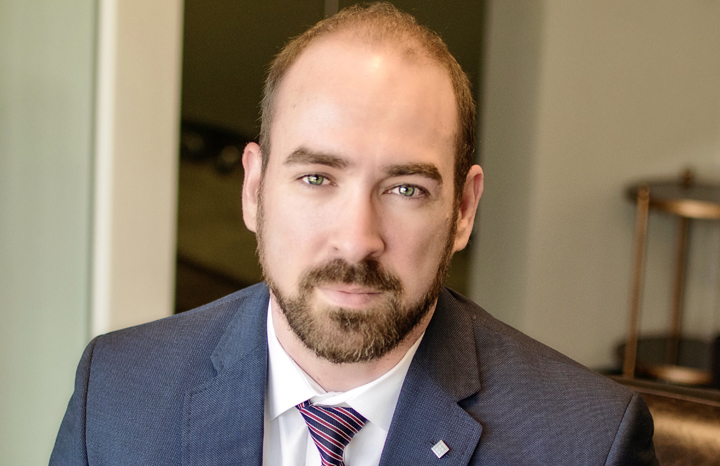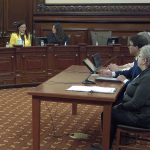
On the record with Dr. Ted Bender, President of UnityPoint Health – UnityPlace

Dr. Ted Bender was recently named president of UnityPoint Health – UnityPlace.
UnityPoint joined forces last year with behavioral health providers the Human Service Center and the Tazwood Center for Wellness to form the Peoria-based nonprofit, which has a focus on substance use disorders.
Bender recently spoke with Health News Illinois about linking services together, the connection between substance use disorders and mental health and how much more money will be needed to address the opioid epidemic.
Edited excerpts are below.
HNI: Tell me a bit more about UnityPlace.
TB: So UnityPlace was formed in April 2019, and it was the coming together of a few like-minded, nonprofit organizations, UnityPoint’s behavioral health side, with the real joint mission of reducing the fragmentation of care and mental health and substance use disorders, with the overarching goal of creating a company that can really handle most mental health problems and substance use disorder problems. Not only that, but it creates a continuum of care with which people can enter at various levels of need and continue throughout the continuum. Some people need a lot more than just a couple of weeks of treatment. Some people need that year-long program of recovery. And with UnityPlace, we really have almost all of those resources in place now to be able to almost completely rehabilitate people with the goal of getting them back into society and being productive members of the area.
HNI: What are some things you hope to bring to the organization?
TB: So all the pieces are in place. Now what we’re really focused on is putting that all together. One thing with mental health and substance use disorders is that access to the proper levels of care can be difficult. There are all kinds of reasons why people may avoid getting treated for certain things. The stigma around mental health and substance use disorders, there’s kind of a general fear of accepting treatment for mental health and the stigma that goes with that. And one thing that I’ve learned in my career is that you gotta do everything you can to remove those barriers. You gotta make it as easy as possible for people to get help, especially in substance use disorders. If you get to the point where you want to go get help and you run into roadblocks, it’s so easy just to say, ‘well, I tried’ and to go right back to using or doing the same things you’ve been doing in the past. So one of the major goals that I have is to really remove as many barriers as possible and create easy access to care.
HNI: Tell me more about the connection between treating addiction and mental health.
TB: So I began my career in substance use disorders at inpatient and outpatient facilities. And you tend to think sometimes that if you’re getting treated for opioid use disorder or amphetamine-related disorders, that you just have to treat the addiction and you’ll be good to go. But I can tell you that it’s much more the norm than the exception to have co-occurring mental health disorders at the same time. It was actually really rare for me to see a patient who was, for example, just diagnosed with alcohol use disorder. It almost always is alcohol use disorder, benzodiazepine use disorder and generalized anxiety disorder. So if you try to just treat the addiction, you may have some success and you may get them sober for a while. But if you’re not focusing on that anxiety piece as well, what do you think they’re going to do the first time they go home and they get really anxious? They’re going to go right back to the coping skills that they know.
So I think it’s critically important to not only be treating one or the other, but to treat both at the same time. And what makes it worse is oftentimes these individuals who are suffering from these illnesses, their health also is suffering. I’ve worked with hundreds of patients who had completely unmanaged diabetes, for example. Their blood sugar was all over the place along with blood pressure issues or weight issues. So at UnityPlace, we have the ability now to integrate not only mental health and substance use disorders, but get them very actively engaged in primary care as well.
HNI: What are some of the challenges you see in increasing access to these services?
TB: I think there’s one area where I want to focus on, and that is to make it very easy for people to know where to go. So, if you’re trying to access care for substance use disorders or you have a specific mental health disorder that you want to get assessed, there’s a ton of different phone numbers out there. There’s a ton of different places you can call. But what I want to do, and what we’re working really hard on right now, is centralizing all that. So there’s one number, and then we can focus on the marketing aspect of it and really pumping this information out into, you know, the tri-county area and the surrounding areas. So everybody knows who to call, one easy number. And then what we can do on our side is get that patient to the right facility for their situation.
HNI: Is there another model this is based on?
TB: I think it’s fairly unique from what I’ve experienced in my career. For me, the biggest reason I took this role is because of that unique aspect. We’re not only trying to create a more efficient model to help the people of central Illinois live a healthier life. If this all goes as planned and works really well, which I’m very confident it will, we may be creating a national model, something that other states or other regions can duplicate or employ to not only help their own regions but the state of mental health and substance use disorders in the country. As you’ve probably been following, the opioid overdose epidemic, the suicide rates are skyrocketing. Teen adolescent suicide rates are skyrocketing all over the United States and it’s not getting better. So it stands to reason that we have to do something differently if we want to expect a different result.
HNI: You talked earlier about the stigmas regarding substance use and mental health. Do you think things are improving on that front?
TB: When I used to run groups for substance use disorders, I used to tell the room that, ‘If we were having a conversation about treating substance use disorders 40 years ago, for example, it wouldn’t be the acceptance and disease model. It would be talking about demonic possession and moral defects of character.’ So I think in that respect we’ve come quite a long way. But it’s not something that is fixed by any means. The stigma around mental health and substance use disorders is still very strong. I think it has improved over the last 10, 20 years, but it’s still a very long road and we have to do everything we can, whenever we can to help reduce that. And at the end of the day, the stigma really surrounds one point. Medical problems are accepted, you should get it treated and get it taken care of. But mental health problems, some people say you should just pick yourself up by the bootstraps and carry on. I’ve told people many times that when someone’s depressed or someone is suffering from severe anxiety, telling them to just cheer up or not worry so much is very unhelpful. Those people know that. They don’t want to be like that. They don’t want to be sad all the time. They don’t want to be nervous and anxious all the time. And it’s much more than just, like I said, picking yourself up by the bootstraps. It’s a disease, it’s an illness and it needs to treated just like any other medical illness.
HNI: What more can policymakers do to support efforts to address addiction recovery and mental health?
TB: When it comes to substance use disorder and mental health disorders, that stigma, I really think, helps prevent the amount of necessary funding that we really need to make an immediate impact. Someone asked me this a year or two ago, what it would take? Really looking at the opioid overdose epidemic right now, what would it take to reduce numbers significantly? $100 billion in the next five years. That, I think, is a good number that would make an immediate impact. But how much money has actually been put into this? Not nearly that much. A good example is Dayton, Ohio. The city was at one point the epicenter for overdose deaths. They were like ground zero, they were losing so many people. The governor at the time, I believe it was John Kasich, he put $1 billion of state funds into the (state opioid) problem. And within one year’s time, they reduced overdose deaths by 50 percent, in one year. The blueprint for success wasn’t some brilliant idea that had never been thought of before. They increased access to care. They opened up more sober living homes. They increased the distribution of Narcan and naloxone. They put a lot of money into public education, prevention methods. It’s all stuff we already know, but it just cost money, and they showed very clearly that this can be done and it can be done now.
Health News Illinois is a nonpartisan, independent news service covering the Illinois healthcare beat. Sign up for a free trial to the newsletter here.









